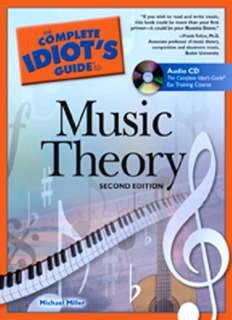‘Music Theory’ PDF Quick download link is given at the bottom of this article. You can see the PDF demo, size of the PDF, page numbers, and direct download Free PDF of ‘Complete Idiot’s Guide To Music Theory’ using the download button.
The Complete Idiot’s Guide To Music Theory PDF Free Download

The Complete Idiot’s Guide To Music Theory
As you recall, polyphony first came to prominence in the fourteenth century largely because of Machaut. Those early masses used the cantus firmus, based on Gregorian chant.
However, in the fifteenth century, secular tunes were introduced into the Mass; The cantus firmus was often based on chansons or other secular tunes and was used to unify all five classes.
By the end of the sixteenth century, the Mass had developed into a disjointed contrapuntal style, as practiced by Giovanni Pierluigi da Palestrina, William Byrd (1542–1623), and others.
The Renaissance-era mass was also more elaborate than that of the medieval period; Composers became more ambitious, using more voices and instruments and adding more and more elaborate ornamentation to the music.
It was during the Renaissance that the mass became a monumental genre, comparable in scope to the symphony of the nineteenth century.
Making More of the Motte At the beginning of the Renaissance, the motet was a relatively small-scale sacred form.
But as the mass form reached its peak in the fifteenth and sixteenth centuries, composers turned to the motet as a medium of experimentation.
These later motets were full of contrasts, with sections for all voices interspersed with sections for only two or three voices, or sections in double time followed by sections in triple time.
This more refined motet form is best exemplified by the works of Orlando de Lassus (1532–1594), who also emphasized the delineation of individual words in the text, incorporating techniques developed earlier in the madrigal form.
Other notable modern composers were Palestrina, who composed 180 motets, and Guillaume Dufay, who introduced secular melodies into the cantus firmus.
Or, why you need to know a little theory
When I was in high school and college (a long time ago, and getting longer every day), most if not many of my fellow students found music theory to be little more fun than listening to paint dry.
I did not share that opinion, and still do not; I think music theory is interesting and fun and an essential part of any serious music education.
Still, if you live by playing your instrument (or singing) 24 hours a day, taking time out of practice to scribble around a bunch of notes on paper might not be too tempting.
In fact, I believe that introductory level music orgy classes are the second most skipped classes in college music schools, only music history classes are less well received.
(Some enterprising soul is bound to combine the two classes into a “Principle of Music History”–or “History of Music Theory”–course, thus creating new levels of student apathy.)
I’m not sure why so many budding musicians are so discouraged by theory.
Maybe it’s because of the way it’s presented. (Let’s face it: When some instructors present this material they can be pretty boring, and most music textbooks are downright boring.)
Perhaps it’s because music theory is so similar to syntax and other boring grammatical stuff.
I do not know; It may seem like a lot of work to some people.
But the fact remains: every musician needs to know some music theory.
This is a bold statement and one to which you may object.
After all, you’ve come this far in studying music without even knowing theory—why do you need to start studying theory now?
Or maybe you know a famous musician who doesn’t know a shred of music theory – and probably doesn’t even know how to read music.
If this person became rich and famous without knowing the theory behind music, then why?
Should You Learn That Theory?
music theory is important
Famous musicians who can’t read musical notes are the exception rather than the rule.
Most musicians, if they want to communicate with other musicians – play in a band, or teach them their songs – need to know at least the basics of how music works.
These basics—notes, chords, etc.—are what we call music theory.
Notes and chords are the building blocks of musical language.
Music the Ori defines several different ways you can organize those blocks into songs and compositions.
Without theory, all you have is noise; By applying music theory, you can create great works of art.
| Writer | Michael Miller |
| Language | English |
| Pages | 338 |
| Pdf Size | 2.23 MB |
| Category | Music |
| Sources | pdfdrive.com |
The Complete Idiot’s Guide To Music Theory Pdf Free Download
